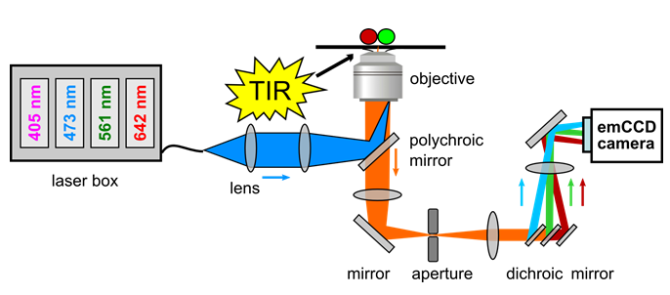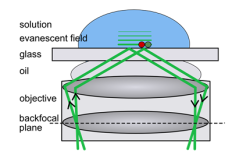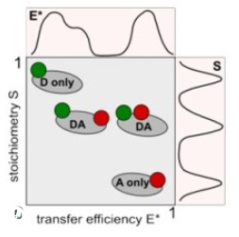Equipment
Single molecule FRET
The home-built single molecule TIRF microscope detects fluorescence in two channels simultaneously, for the images of single molecule FRET.
Our single-molecule microscopy (SMM) setup is a home-built total internal reflection fluorescence (TIRF) microscope with 4 (alternating) laser excitation channels and three emission channels. It can therefore be used for single-molecule Förster Resonance Energy Transfer (FRET) spectroscopy, as well as super-resolution microscopy techniques such as photoactivated localization microscopy (PALM) and stochastic optical reconstruction microscopy (STORM).

Principle of TIRF
In TIRF microscopy the laser light is focused into the rim of the backfocal plane of the microscope objective such as that the laser light is totally reflected at the glass/ water interface. An evanescent field is created in which intensity decays within a few hundred nanometre. Thereby, only a small volume above the coverslide is illuminated.

smFRET is a well-established technique to measure distances between two fluorophores with high spatial (nanometre) and temporal (millisecond) resolution. In FRET, the proportion of transferred energy between donor fluorophore and an acceptor fluorophore depends strongly on the distance r between them. This makes the technique useful to study, for example, conformational dynamics of enzymes such as DNA polymerases. In the SMM set-up, we detect fluorophores close to the surface within an area of roughly 50 by 50 micrometer by imaging the emitted with an emCCD camera. We can detect hundreds of single molecules in parallel with TIRF microscopy.

A very important addition to the concept of single-molecule FRET was the development of ALEX (Alternating Laser Excitation): instead of exciting only the donor fluorophore and measuring the energy transfer to the acceptor at all times, the acceptor is repeatedly directly excited in order to probe its existence. If there is, for example, no red fluorescence detectable after red excitation, the acceptor is already bleached and is not participating in FRET any more. The detection of red fluorescence after red excitation allows the introduction of a new parameter called stoichiometry, which relates the green and red fluorescence after green excitation to the overall fluorescence emission after green and red excitation. The figure shows an ES histogram allowing the clear separation of species which cannot easily be resolved on the E histogram alone.
